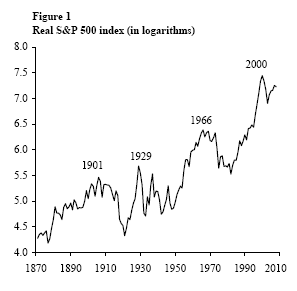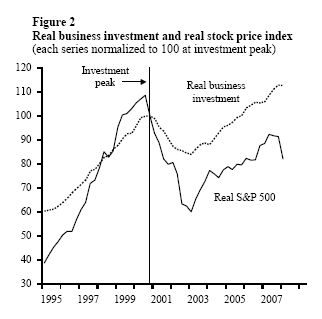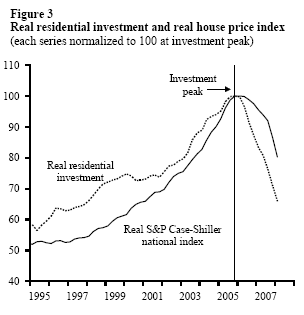The magnitude of short-term movements in asset prices remains a challenge to explain within a framework of rational, efficient markets. Numerous empirical studies have shown that stock prices appear to exhibit “excess volatility,” that is, prices move too much to be explained by changes in the underlying fundamentals, such as dividends or cash flows.
- Bubbles and new era enthusiasm
- Business investment and the stock bubble
- Residential investment and the housing bubble
- Conclusion
- References
Bubbles are often precipitated by perceptions of real improvements in the productivity and underlying profitability of the corporate economy. But as history attests, investors then too often exaggerate the extent of the improvement in economic fundamentals.
—Greenspan (2002)
The magnitude of short-term movements in asset prices remains a challenge to explain within a framework of rational, efficient markets. Numerous empirical studies have shown that stock prices appear to exhibit “excess volatility,” that is, prices move too much to be explained by changes in the underlying fundamentals, such as dividends or cash flows. Another prominent feature of asset prices is the intermittent occurrence of sustained run-ups above estimates of fundamental value, so-called speculative bubbles, that can be found throughout history in various countries and markets (see Lansing 2007).
The dramatic rise in U.S. stock prices during the late 1990s, followed similarly by U.S. house prices during the mid-2000s, are episodes that have both been described as bubbles. The former was accompanied by a boom in business investment, and the latter by a boom in residential investment. Both booms were later followed by falling asset prices and severe retrenchments in the associated investment series, as firms and investors sought to unwind the excess capital accumulated during the bubble periods. Coincident booms in asset prices and investment also occurred during the late 1920s—a period that shares many characteristics with the late 1990s. In particular, both periods witnessed major technological innovations that contributed to investor enthusiasm about a “new era.” This Economic Letter examines some historical links between speculative bubbles, technological innovation, and capital misallocation.
Bubbles and new era enthusiasm
Shiller (2000) argues that investors overreact to technological innovations. He shows that major stock price run-ups have generally coincided with the emergence of some superficially plausible “new era” theory in the popular culture that extols the virtues of new technology. New era economic thinking is then used to justify a meteoric rise in asset prices and the abandonment of traditional valuation metrics.
 Figure 1 depicts four major run-ups in the real (inflation-adjusted) S&P 500 stock index. Shiller associates each run-up with the following technological advances that contributed to new era enthusiasm:
Figure 1 depicts four major run-ups in the real (inflation-adjusted) S&P 500 stock index. Shiller associates each run-up with the following technological advances that contributed to new era enthusiasm:
-Early 1900s: High-speed rail travel, transatlantic radio, long-line electrical transmission.
-1920s: Mass-production of automobiles, travel by highways and roads, commercial radio broadcasts, widespread electrification of manufacturing.
-1950s and 60s: Widespread introduction of television, advent of the suburban lifestyle, space travel.
-Late 1990s: Widespread availability of the internet, innovations in computers and information technology, emergence of the web-based business model.
In comparing the late 1920s with the late 1990s, Gordon (2006) and White (2006) emphasize the simultaneous occurrence of major technological innovations, a productivity revival, excess capital investment, and a stock market bubble fueled by speculation. The September 7, 1929, edition of Business Week remarked, “For five years at least, American business has been in the grip of an apocalyptic holy-rolling exaltation over the unparalleled prosperity of the ‘new era’ upon which we, or it, or somebody has entered.” Along similar lines, the March 8, 1999, cover story of Business Week proclaimed, “The high-tech industry is on the cusp of a new era in computing in which digital smarts won’t be tied up in a mainframe, minicomputer, or PC. Instead, computing will come in a vast array of devices aimed at practically every aspect of our daily lives.”
Business investment and the stock bubble
From 1996 until its peak in 2000, real business investment expanded at an average compound growth rate of 10% per year—about 2.5 times faster than the growth rate of the U.S. economy as a whole. Much of the surge in business investment in the late 1990s was linked to computers and information technology. During these years, measured productivity growth picked up, which was often cited as evidence of a permanent structural change—one that portended faster trend growth going forward. Widespread belief in the so-called “new economy” caused investors to bid up stock prices to unprecedented levels relative to corporate earnings.
The investment boom of the late 1990s now appears to have been overdone. Firms overinvested in new productive capacity in an effort to satisfy a level of demand for their products that proved to be unsustainable. Gordon (2003) documents the many transitory factors that boosted the demand for technology products during the late 1990s. These include telecom industry deregulation, the one-time invention of the World Wide Web, the surge in equipment and software demand from the now-defunct dotcoms, and a compressed personal computer replacement cycle heading into Y2K.
 Caballero et al. (2006) argue that rapidly rising stock prices provided firms with a low-cost source of funds from which to finance their investment projects. The resulting surge in capital accumulation served to increase measured productivity growth which, in turn, helped to justify the enormous run-up in stock prices. Figure 2 shows that the trajectory of the S&P 500 stock index, both before and after the bubble peak, is strikingly similar to the trajectory of business investment.
Caballero et al. (2006) argue that rapidly rising stock prices provided firms with a low-cost source of funds from which to finance their investment projects. The resulting surge in capital accumulation served to increase measured productivity growth which, in turn, helped to justify the enormous run-up in stock prices. Figure 2 shows that the trajectory of the S&P 500 stock index, both before and after the bubble peak, is strikingly similar to the trajectory of business investment.
On January 13, 2000, near the peak of the stock bubble, Fed Chairman Alan Greenspan raised the possibility that investors might have overreacted to recent productivity-enhancing innovations: “When we look back at the 1990s, from the perspective of say 2010…[w]e may conceivably conclude from that vantage point that, at the turn of the millennium, the American economy was experiencing a once-in-a-century acceleration of innovation, which propelled forward productivity, output, corporate profits, and stock prices at a pace not seen in generations, if ever. Alternatively, that 2010 retrospective might well conclude that a good deal of what we are currently experiencing was just one of the many euphoric speculative bubbles that have dotted human history. And, of course, we cannot rule out that we may look back and conclude that elements from both scenarios have been in play in recent years.”
Residential investment and the housing bubble
 Figure 3 shows that one can observe similar comovement between asset prices and investment in the U.S. housing market. From 2001 to 2006, house prices nearly doubled, rising much faster than the underlying fundamentals, as measured by rents or household income. An accommodative interest rate environment, combined with a proliferation of new mortgage products (loans with little or no down payment, minimal documentation of income, and payments for interest-only or less), helped fuel the run-up in house prices. At the time, Fed Chairman Greenspan (2005) offered the view that the financial services sector had been dramatically transformed by advances in information technology, thus enabling lenders “to quite efficiently judge the risk posed by individual applicants and to price that risk appropriately.” Feldstein (2007), citing a number of studies, argues that the rapid growth in subprime lending during these years was driven in part by “the widespread use of statistical risk assessment models by lenders.”
Figure 3 shows that one can observe similar comovement between asset prices and investment in the U.S. housing market. From 2001 to 2006, house prices nearly doubled, rising much faster than the underlying fundamentals, as measured by rents or household income. An accommodative interest rate environment, combined with a proliferation of new mortgage products (loans with little or no down payment, minimal documentation of income, and payments for interest-only or less), helped fuel the run-up in house prices. At the time, Fed Chairman Greenspan (2005) offered the view that the financial services sector had been dramatically transformed by advances in information technology, thus enabling lenders “to quite efficiently judge the risk posed by individual applicants and to price that risk appropriately.” Feldstein (2007), citing a number of studies, argues that the rapid growth in subprime lending during these years was driven in part by “the widespread use of statistical risk assessment models by lenders.”
The subprime lending boom was later followed by a sharp rise in delinquencies and foreclosures, the collapse of numerous mortgage lenders, massive write-downs in the value of securities backed by subprime mortgages, and record-setting levels of unsold new homes. In retrospect, enthusiasm for a “new era” in credit risk modeling appears to have been overdone. Persons (1930 pp. 118-119) describes the fallout from an earlier era of rapid credit expansion as follows: “It is highly probable that a considerable volume of sales recently made were based on credit ratings only justifiable on the theory that flush times were to continue indefinitely….When the process of expanding credit ceases and we return to a normal basis of spending each year…there must ensue a painful period of readjustment.”
History tells us that periods of major technological innovation are often accompanied by speculative bubbles as investors overreact to genuine advances in productivity. Excessive run-ups in asset prices can have important consequences for the economy as firms and investors respond to the price signals, resulting in capital misallocation. Lansing (2008) shows that even from the narrow perspective of a theoretical model, it remains an open question whether speculative behavior is harmful to society.
On the one hand, speculation can magnify the volatility of economic and financial variables, thus harming the welfare of those who are averse to uncertainty and fluctuations. On the other hand, speculation can increase investment in risky ventures, thus yielding benefits to a society that suffers from an underinvestment problem. It should be noted, of course, that the theoretical model abstracts from numerous real-world issues that would affect welfare. One such issue is financial fraud, which has typically accompanied historical bubble episodes. Indeed, the proliferation of fraudulent stock-offering schemes in England during the famous price run-up of shares in the South Sea Company led the British government to pass the so-called “Bubble Act” in 1720 (see Gerding 2006).
Regarding the merits of speculation, Meeker (1922, p. 419), the economist of the New York Stock Exchange, wrote: “Of all the peoples in history, the American people can least afford to condemn speculation….The discovery of America was made possible by a loan based on the collateral of Queen Isabella’s crown jewels, and at interest, beside which even the call rates of 1919-1920 look coy and bashful. Financing an unknown foreigner to sail the unknown deep in three cockleshell boats in the hope of discovering a mythical Zipangu [land of gold] cannot, by the widest exercise of language, be called a ‘conservative investment.’”
Kevin J. Lansing
Senior Economist
[URLs accessed June 2008.]
Caballero, R.J., E. Farhi, and M.L. Hammour. 2006. “Speculative Growth: Hints from the U.S. Economy.” American Economic Review 96, pp. 1,159—1,192.
Feldstein, M.S. 2007. “Housing, Credit Markets, and the Business Cycle.” NBER Working Paper 13471.
Gerding, E.F. 2006. “The Next Epidemic: Bubbles and the Growth and Decay of Securities Regulation.” Connecticut Law Review 38(3), pp. 393-453.
Gordon, R.J. 2003. “Hi-Tech Innovation and Productivity Growth: Does Supply Create Its Own Demand?” NBER Working Paper 9437.
Gordon, R.J. 2006. “The 1920s and the 1990s in Mutual Reflection.” In The Global Economy in the 1990s, eds. P.W. Rhode and G. Toniolo. Cambridge: Cambridge University Press, pp. 161-192.
Greenspan, A. 2000. “Technology and the Economy.” Remarks. New York City, January 13.
Greenspan, A. 2002. “Economic Volatility.” Remarks. Jackson Hole, WY, August 30.
Greenspan, A. 2005. “Consumer Finance.” Remarks. Washington, DC, April 8.
Lansing, K.J. 2007. “Asset Price Bubbles.” FRBSF Economic Letter 2007-32 (October 26).
Lansing, K.J. 2008. “Speculative Growth and Overreaction to Technology Shocks.” FRBSF Working Paper 2008-08.
Meeker, J.E. 1922. The Work of the Stock Exchange. New York: Ronald Press.
Persons, C.E. 1930 “Credit Expansion, 1920 to 1929, and Its Lessons.” Quarterly Journal of Economics 45, 94-130.
Shiller, R.J. 2000. Irrational Exuberance. Princeton, NJ: Princeton University Press.
White, E.N. 2006. “Bubbles and Busts: The 1990s in the Mirror of the 1920s.” In The Global Economy in the 1990s, eds. P.W. Rhode and G. Toniolo. Cambridge: Cambridge University Press, pp. 193-217.
Opinions expressed in FRBSF Economic Letter do not necessarily reflect the views of the management of the Federal Reserve Bank of San Francisco or of the Board of Governors of the Federal Reserve System. This publication is edited by Anita Todd and Karen Barnes. Permission to reprint portions of articles or whole articles must be obtained in writing. Please send editorial comments and requests for reprint permission to research.library@sf.frb.org